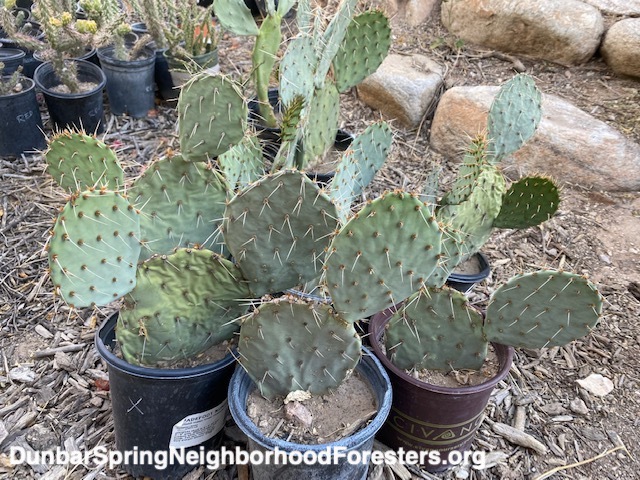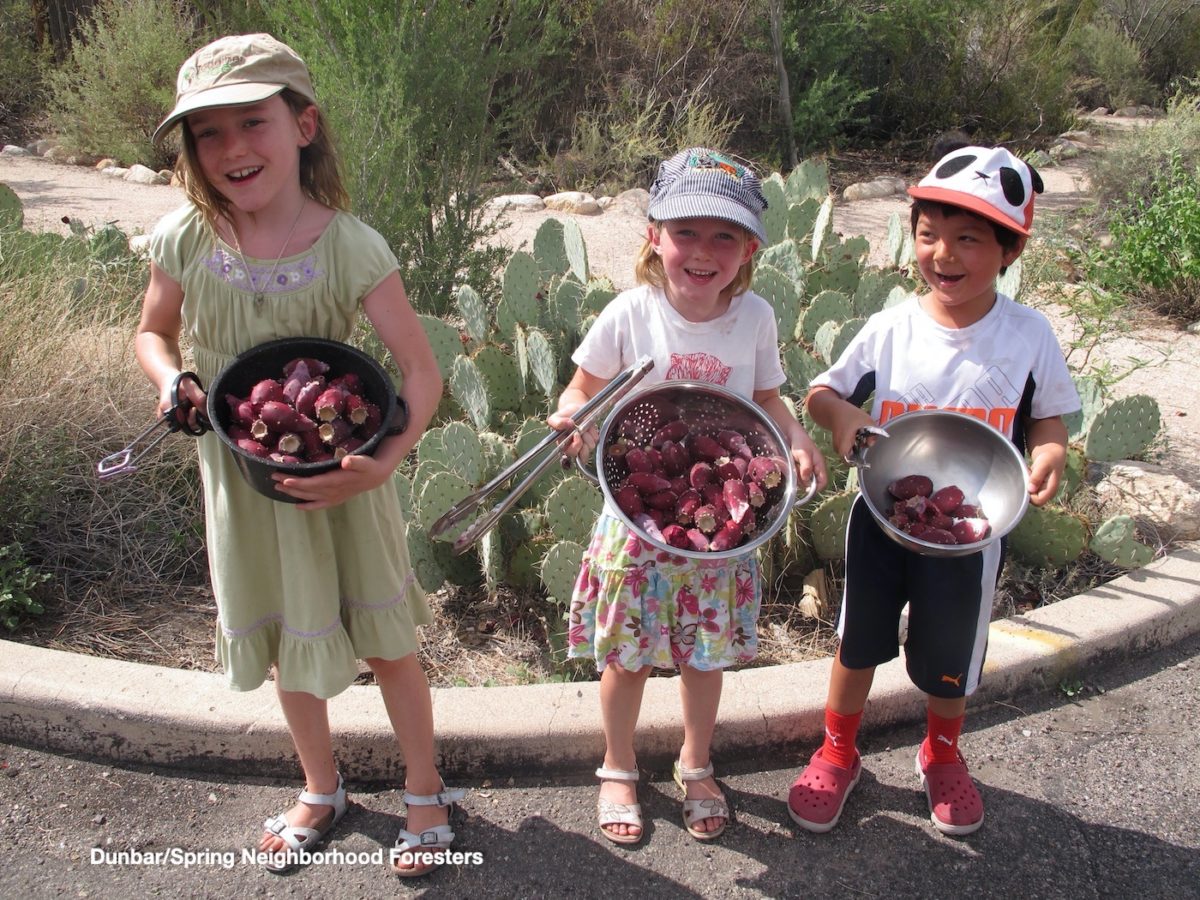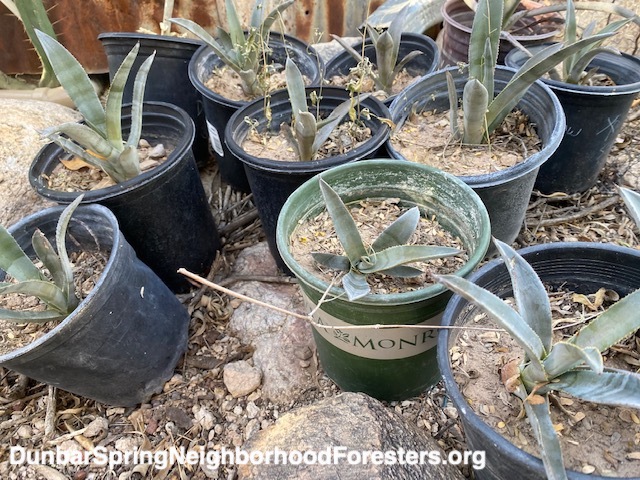Staghorn cholla
Cholla flower buds are a delicious native food you can grow at home or in the public right-of-way (as long as you keep public walkways clear and accessible). They also make incredible wildlife habitat. See here for the many benefits of cholla.
We have 1-gallon-sized specimens available at $10 each.
Flower colors available include: pink, red, yellow, purple, orange, lavender, or yellow-pink. Each individual plant has its own flower color, and has been labeled with what flower color it has. For photos of some of these flowers scroll to bottom of this link.

Engelmann’s prickly pear
In addition we have a native cultivar of engelman’s prickly pear that was selected for particularly delicious fruits. These are also 1-gallon specimens available for $10 each.


More info on prickly pear:
OPUNTIA SPP. – PRICKLY PEAR (Cactaceae – Cactus Family) subgroup Platyopuntia::
Spanish name: nopal
O’odham name: naw
Yeome name: naavo
Plants have flattened stems or “pads”. Wildlife – bees love the flowers in spring; white-winged dove, cactus wren, curve-billed thrasher, coyote, rabbits, ground squirrel, k-rat, javalina, and desert tortoise all go for the fruits and/or the seeds; cochineal scale insects feed on pads. Edible – ripe fruits eaten raw or cooked are a good source of vitamins A and C (Niethammer, 1987) and calcium (Niethammer, 1974); used in pasteries, juice, jams, syrup, beverages, and candied (Niethammer, 1987), (TOG); an easy way to process the fruits for syrup or juice is to freeze them after harvesting, then later thaw them out in a colindar lined with an old pillow case. As the fruits thaw they will collapse and you can easy mash and/or squeeze the juice through the pillow case and into a bucket below – that’s it! The thorns, seeds, and most of the pulp will remain in the pillow case. Empty the pulp and thorns out of the pillow case into your compost pile, and if you like save the seed to grind into flour.; seeds can be used in a wild flour mixture (Nyerges, 1998); young pads are cooked and eaten (Niethammer, 1987), (Bigfoot) – great for diabetics (Moore, 1989), (Dahl, 1995), (Nabhan, 1991). On a long desert hike I ate about half a dozen raw flower buds close to blooming and four young pads dethorned, and found them all filling and satisfying. Fruit harvest begins in July (Dahl, 1995). I’ve found the flower petals of many varieties to be edible and faintly sweet in flavor. Medicinal (Bigfoot), (Curtin, 1997), (Kay, 1996), (Cheatham, 1998), (Niethammer, 1974). Other uses – fruit used to make various colors of dye (Rieske), (Cheatham, 1998); white and fuzzy cochineal insect scales, Dactylopius coccus , feeding on the pads can be used for a high quality red dye (Las Aranas, 1995), (Ebeling, 1986); pads are a source of black pigment for painting ceramics (Swink, 1998); slimy juice from cut up cactus pads is sometimes added to whitewash (Cheatham, 1998); grilled pads dropped into muddy water reportedly clairfy the water (Cheatham, 1998), (Bigfoot); makes a great living fence; cattle will can eat the cactus if the thorns have been singed off (Niethammer, 1974). The prickly pear pads are also used to semi-stabalize (make more water resistant) adobe bricks and earth plasters (the thornless Opuntia ficus indica is the easiest to use, but thornier native species could be used). Cut the pads up, immerse them in water, and cover (as they ferment and decompose it will STINK), leaving 1 to 2 weeks. Once the water becomes slimy it is ready. Use this as your water source when you mix the adobe you wish to be semi-stabalized. This “cactus water” can also be diluted with 3 – 4 parts water when mixing lime plasters. If you’re working with old bags of lime the cactus juice can help restore the lime to fresher characteristics (easier to work and holds up better). Caution – Herbalist Peter Bigfoot has found eating pads from prickly pear with red-orange thorns made him ill, he has found prickly pears with all white thorns don’t seem to have this effect (Bigfoot). I also personally know and read of some other people getting ill with “chills” if they ate too many fruits at one time. Guild associates – foothills palo verde, cat claw acacia, mormon tea, fairy duster, hopbush, sotol. Evergreen. low-water-use.
OPUNTIA ENGELMANNII – ENGELMANN PRICKLY PEAR: Blooms (yellow) April – June. Fruit is red to reddish-purple when ripe. 1,000 – 6,500′. Blue-green pads can be up to 12″ long. Can grow to 5′ tall. Found on plains, hillsides, mesas, arroyos, and washes. Wildlife – solitary bees (Anthophoridae, Halictidae, Megachilidae) and sap bettles (Nitidulidae) visit the flowers (Turner, et al 1995); coyote, javalina, black bear, and desert tortoise go for the fruit and disperse the seed; javalina also eat pads with fewer thorns. Edible – once the thorns are removed the sweet fruit can be eaten raw (Rea, 1997 ). Other uses – thorns used for tattooing (Rea, 1997 ); fruit used for dye (Las Aranas, 1995).
Agave murpheyi
And we have agave murpheyi a native cultivar that can reproduce by pups that grow at the base of the mother plant. These are 1-gallon-sized available for $10 each.

More info on agave murpheyi:
AGAVE SPP. – AGAVE (Amaryllidaceae – Amaryllis Family):
Spanish name(s): agave, lechuguilla, mescal, maguey
O’odham name: a’ud
Yoeme name: kuu’u
A deserti, A. Palmeri (larger species), A. chrysantha, A. Murpheyi like the Tucson climate. Wildlife – flowers attract hummingbirds, pollinating bats, and insects (including honeybees, bumblebees, butterflies, carpenter bees, paper wasps, and tarantula hawks – insects attract birds such as Hooded Orioles and bats which also love the flowers’ nectar; flower stalks attact carpenter bees; the larvae of giant skippers (of the family Megathymidae and resembling moths) sometimes infest the plant – but they are not a pest, but a food source – they can be roasted and eaten (Ebeling, 1986); leaves are browsed by bighorn sheep. Edible – heart of plant and emerging flower stalk are roasted for a starchy food – I find the flavor to resemble sweet and fiberous yams, while fermented beverages (pulque, tequila) are distilled from the sap (Facciola, 1998), (Niethammer, 1974). A 1/4 cup serving of prepared agave provides thirty calories and more calcium than a half a glass of milk (Niethammer, 1974). A sweetish liquid was collected from flowers after a rain and drunk (Niethammer, 1974). The flowers were collected and boiled (Niethammer, 1974). Young flower stalk can also be eaten raw (Bigfoot). Food harvest Nov. – Feb. (Dahl, 1995); flour can be made from seeds boiled and ground or fruits boiled and mashed (Nyerges, 1998); a syrup can be made from baked or well-soaked leaves mashed and simmered in water…with fibers later removed the juice is boiled down (Niethammer, 1974); baked agave pulp mixed with ground seeds and nuts makes for a nice agave nutbutter (Niethammer, 1974); .good food for diabetics (Nabhan, 1991); the larvae of giant skippers (of the family Megathymidae and resembling moths) which sometimes infest the plant can be roasted and eaten (Ebeling, 1986). Medicinal (Moore, 1989 ), (Kay, 1996 ), (Niethammer, 1974). Other uses – fresh grated root used for shampoo (Moore, 1989 ); soap made from leaves (Dahl, 1995); fibers make rope, sandals, baskets, etc (Jensen, 1991), (Bigfoot); flower stalk used to make arrow shafts, fiddles, a pole for picking saguaro fruit, and fire kits (Abril, 1998); dried and hollowed flower stalks are used to make diggeri doos; the agave heart once dry can be used for containers, fuel for fires (Abril, 1998), and masks; leaves can be used for roofing, fuel for fires, face paint, brushes, pottery rests, and paper (Abril, 1998); juice can be used for arrow tip poison and fish poison (Abril, 1998); seeds can be used as beads (Abril, 1998); a light brown paint can be made from the hardened agave juice covering pit stones after baking (Niethammer, 1974); agave juice was used as waterproofing (Niethammer, 1974); erosion control (Cheatham, 1998). Caution – raw agave is poisonous. Do not try even one nibble of this plant in the uncooked state or your mouth may be badly burned (Niethammer, 1974). The agave juice or sap can irritate the skin, and be particuarly bad if it gets into broken skin so wear protective clothing when working with the plants. Roasting or soaking plant parts in water to induce rot can make materials safer to handle. Guild associates – velvet mesquite, cat claw acacia, jojoba. Evergreen. low-water-use.
A. MURPHEYI – MURPHY’S AGAVE: Blooms March – April. May be an ancient Indian cultivar grown for eating and mescal (Ebeling, 1986). Some reasons (extracted from Adams 1998) why this species may have been cultivated include:
• can grow to a mature plant with abundant carbohydrate reserves in as little as nine years.
• the acidic liquid in the leaf tissue is less caustic to human skin than other agaves.
• the heart or caudex is ready for havest mid-winter, a potentially food stressed time of year, as the plant prepares to send up its flowering stalk. This is up to 3 months earlier than other agaves.
Where we ideally would like to prioritize plantings
Priority will be given to those who will plant in public right-of-way areas (chicanes, round-a-bouts, along public walkways) of the neighborhood forest if they agree to maintain/steward the plantings. We can also provide guidance and help with that stewarding and such plantings. (Though it is great to also have these plantings in yards – best to have them on perimeter of yards by fences or walls where they add to, rather than create new, barriers).
We will also prioritize Dunbar/Spring Neighborhood Forest plantings. Our hope is that every neighborhood will set up their own backyard nurseries – and we can provide information on how to do this. It is very easy to start such a nursery with such hardy species as those offered here. These very plants could become mother plants from which you take and propagate cuttings or pups year after year.
And we’ll prioritize plants to those who have committed to attaining any level of neighborhood forester.
Watering needs to get the plants established
Plants will need to be watered regularly (once per week) from now till fall to ensure they get well established. Once established, you should no longer need to water them.


